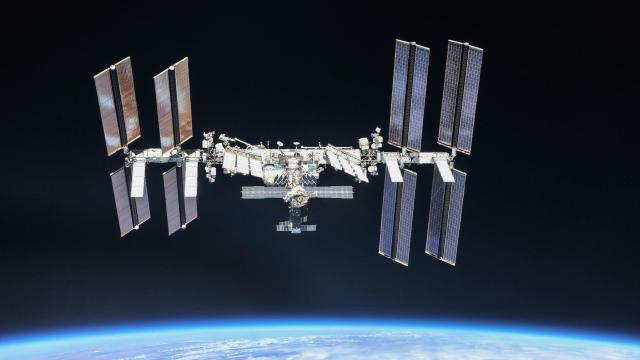Yesterday, NASA and Russian flight controllers performed an “avoidance manoeuvre” to protect the International Space Station from a wayward chunk of space debris. This episode — already the third of its kind this year — highlights a growing problem and the importance of mitigating potential collisions in space.
Low Earth orbit (LEO) is vast and mostly empty, but when you have thousands upon thousands of objects zipping around at speeds over 10 km per second, this space in space suddenly seems a lot smaller.
Such was the concern earlier this week when NASA, along with U.S. Space Command, detected an unknown piece of space debris that was expected to come uncomfortably close to the International Space Station. To safeguard the outpost and its crew, NASA and Russian flight controllers scheduled an impromptu “avoidance manoeuvre” to place the ISS out of harm’s way.
To do so, they fired thrusters belonging to Russia’s Progress 75 resupply spacecraft, which is currently docked to the Zvezda service module. Given the late notice, mission controllers had all three members of the Expedition 63 crew — Chris Cassidy, Anatoly Ivanishin, and Ivan Vagner — temporarily relocate to the Russian segment so they could be in close proximity to the Soyuz MS-16 spacecraft. NASA said this was done “out of an abundance of caution” and that “at no time was the crew in any danger.”
The piece of space junk was projected to pass to within 1.39 kilometres of the International Space Station, with the closest approach happening on Tuesday, September 23 at 11:21 a.m. AEST. The avoidance manoeuvre, which required just 150 seconds to complete, was performed about an hour earlier. NASA and Russian flight controllers worked in tandem to make it happen.
Once it was all over, the hatches between the U.S. and Russian segments were reopened and life resumed to normal.
“Manoeuvre Burn complete,” declared NASA chief Jim Bridenstine in a tweet, “The astronauts are coming out of safe haven.”
The debris object that ISS avoided is now available on SpaceTrack as 2018-084CQ, 46477, from the breakup of Japan’s H-2A F40 rocket stage. At 2221:07 UTC it passed within a few km of ISS at a relative velocity of 14 6 km/s, 422 km over the Pitcairn Is in the S Pacific pic.twitter.com/2T3yFQoFMT
— Jonathan McDowell (@planet4589) September 22, 2020
Writing in a series of tweets, Harvard astrophysicist Jonathan McDowell identified the object as being debris from Japan’s H-2A F40 rocket stage, which broke up last year. He said the debris passed to within a few kilometers “of the position ISS would have been at if it hadn’t manoeuvred.” The errant chunk was clocked at 146 km per second and flew about 422 km above the Pitcairn islands in the South Pacific. This rocket stage produced 77 individual pieces of debris, of which five have already fallen into Earth’s atmosphere, according to McDowell, an expert on space traffic.
Bits of space debris, even small ones, pose a tremendous risk to satellites, the ISS, astronauts, and anything else in LEO due to their high velocities. What’s more, a collision can then produce even more pieces of space debris, leading to a snowball effect and even more collisions.
Bridenstine said this is the third time the ISS has had to move this year to avoid space debris, and in the last two weeks there “have been 3 high concern potential conjunctions,” he tweeted. “Debris is getting worse!” he exclaimed, saying it’s time for Congress to provide the U.S. Commerce Department with the $US15 ($21) million requested by President Trump for the Office of Space Commerce, in reference to a LEO commercialization initiative and the prioritisation of “orbital debris management.”
The @Space_Station has maneuvered 3 times in 2020 to avoid debris. In the last 2 weeks, there have been 3 high concern potential conjunctions. Debris is getting worse! Time for Congress to provide @CommerceGov with the $15 mil requested by @POTUS for the Office of Space Commerce.
— Jim Bridenstine (@JimBridenstine) September 22, 2020
Bridenstine is right to leverage this situation, as the problem does seem to be getting worse. Earlier this year, two decommissioned satellites narrowly avoided each other; their collision would’ve produced thousands of new pieces of space debris. Active satellites are constantly having to be reoriented to avoid collisions, but the addition of thousands of satellites, such as Elon Musk’s Starlink satellite constellation (which had a close call in 2019), will make these manoeuvres more commonplace. It’s just a matter of time before a seriously destructive collision finally happens.
To mitigate the risks, we need to minimise and reduce the number of objects in low Earth orbit (such as designing satellites capable of de-orbiting themselves when their work is done) and devise creative ways of decluttering LEO (like harpoons). We also need to track all these objects and continually run calculations to flag potential collisions. A recent breakthrough, in which lasers were used to spot tiny pieces of debris during daylight hours, represents a step in this direction.
Ultimately, however, we need to limit the quantity of objects being sent into orbit (especially superfluous pet projects), craft sensible laws, and demand better global governance of space-based activities.
